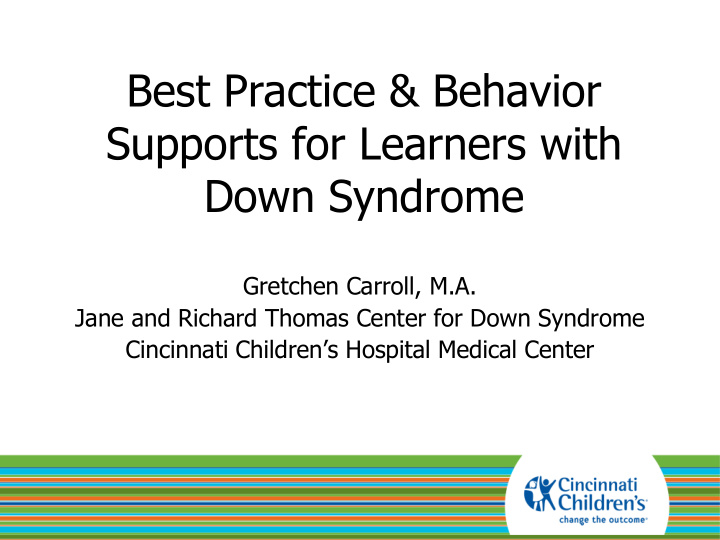



Best Practice & Behavior Supports for Learners with Down Syndrome Gretchen Carroll, M.A. Jane and Richard Thomas Center for Down Syndrome Cincinnati Children’s Hospital Medical Center
Approaching the Hot Topic of Behavior • Why It Matters • Understanding Problematic Behavior • Preventing Problematic Behavior • Replacing Problematic Behavior • Responding to Problematic Behavior
Potential Behavioral Challenges • Difficulty with • Physical Behaviors transitions • Noises, sensory • Poor compliance stimulations • “Stubbornness” • Inappropriate Language • Inattention • Flight • Impulsivity
Why It Matters Behavior affects learning Behavior affects social relationships Behavior affects independence Behavior affects placement
Understanding Problematic Behavior Every behavior is a form of communication What is the behavior saying? I don’t understand/This is hard for me I want to do something else I want you to pay attention to me I am tired/physically uncomfortable I have a sensory need
The Importance of a Functional Behavior Assessment & IEP Goals Components – Antecedents/triggers – Behavior itself – Events/consequences following the behavior – Hypothesis about function of behavior – Development of Formal Behavior Plan IEP Behavior Goals
Interventions to Prevent Problematic Behavior • Awareness of setting events • Use of reinforcers/rewards/tokens • Offering choices • High probability sequence request • Collaboration • Preferred item as distractor
Interventions to Prevent Problematic Behavior • Picture schedules • Positive, visual behavior plans – Behavior charts based on portions of day – Behavior charts based on task completion • Written/video social stories • Regular sensory breaks
The Critical Role of Modification in Supporting Behavior Consider modification of the academic task – Change the delivery of the information – Change the output required by the learner – Change the pace of delivery – Change the amount of content – Change the content itself
Replacing Problematic Behavior Teaching replacement skills – Replacement behavior should serve same function as non-desired behavior – Visual, tactile, readily available – May require direct teaching and repetition – Reinforce replacement behavior strongly
Responding to Problematic Behavior • Diversion and distraction • Offer choice to return to appropriate behavior • Short, specific consequence with focus on desired activity • Ignore attention seeking behavior (when possible)
Reframing our view of behavior challenges of students with Down syndrome
Sources https://library.down-syndrome.org/en- us/research-practice/12/2/strategies- address-challenging-behaviour-young-down- syndrome/
Recommend
More recommend